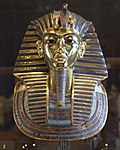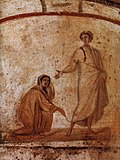Funerary art is any work of art forming, or placed in, a repository for the remains of the dead. The term encompasses a wide variety of forms, including...
93 KB (12,126 words) - 05:13, 4 August 2024
The funerary art of ancient Rome changed throughout the course of the Roman Republic and the Empire and took many different forms. There were two main...
65 KB (8,500 words) - 19:12, 17 July 2024
and their art. Etruscan art is usually divided into a number of periods: 900 to 700 BC – Villanovan period. Already the emphasis on funerary art is evident...
33 KB (3,899 words) - 05:41, 20 June 2024
Funerary art in Puritan New England encompasses graveyard headstones carved between c. 1640 and the late 18th century by the Puritans, founders of the...
31 KB (4,178 words) - 23:11, 13 June 2024
Ancient Egyptian funerary practices of the wealthy included the per nefer, house of beauty Memorial Memorial bench Commemorative plaque Funerary art...
2 KB (173 words) - 13:45, 23 May 2024
judge the deceased, but simply to guide them. Appearing frequently on funerary art, psychopomps have been depicted at different times and in different cultures...
9 KB (923 words) - 19:22, 29 August 2024
Roman funerary practices include the Ancient Romans' religious rituals concerning funerals, cremations, and burials. They were part of time-hallowed tradition...
133 KB (19,105 words) - 13:26, 4 August 2024
Art Museum (Baltimore, US) 1st–2nd century AD; bronze or copper alloy; 20.6 × 14 cm; Metropolitan Museum of Art The earliest purpose-built funerary containers...
154 KB (18,298 words) - 14:35, 26 August 2024
Memento mori (category Christian art about death)
philosophers of classical antiquity and Christianity, and appeared in funerary art and architecture from the medieval period onwards. The most common motif...
39 KB (3,799 words) - 20:48, 26 July 2024
chthonic figure in Etruscan mythology shown in a variety of forms of funerary art, such as in tomb paintings and on sarcophagi. Vanth is a female demon...
6 KB (836 words) - 18:35, 4 September 2024
monuments first appeared in the 1380s and remained a popular form of funerary art for 200 subsequent years. In a still widely debated theory popularized...
15 KB (1,885 words) - 17:36, 18 June 2024
Roman sculpture (redirect from Figures in roman art)
Roman funerary art also offers a variety of scenes from everyday life, such as game-playing, hunting, and military endeavors. Early Christian art quickly...
36 KB (4,010 words) - 22:03, 28 December 2023
Terracotta Army (category Funerary art)
armies of Qin Shi Huang, the first emperor of China. It is a form of funerary art buried with the emperor in 210–209 BCE with the purpose of protecting...
82 KB (8,240 words) - 07:11, 3 September 2024
should normally be considered as genderless. In 19th-century art, especially funerary art, this traditional convention is sometimes abandoned. The lack...
33 KB (3,752 words) - 18:26, 3 September 2024
Brompton Cemetery (section Funerary art)
avenue, from North Lodge Brompton Cemetery Magnificent Seven cemeteries Funerary art London Cemetery and Extension Victorian cemetery Commonwealth War Graves...
44 KB (4,519 words) - 18:25, 14 July 2024
Grave goods (redirect from Funerary objects)
social status played a role in what was left and how often it was left. Funerary art is a broad term but generally means artworks made specifically to decorate...
18 KB (1,994 words) - 21:22, 12 July 2024
protection between rituals. Ancient grave markers typically incorporated funerary art, especially details in stone relief. With greater literacy, more markers...
33 KB (3,638 words) - 00:32, 27 August 2024
Anubis (section Portrayal in art)
Anpu in Ancient Egyptian (Coptic: ⲁⲛⲟⲩⲡ, romanized: Anoup), is the god of funerary rites, protector of graves, and guide to the underworld, in ancient Egyptian...
33 KB (3,545 words) - 01:43, 13 July 2024
Sarcophagus of the Spouses (category Funerary art)
Period. The Etruscans were well known for their terracotta sculptures and funerary art, largely sarcophagi and urns. The sarcophagus is a late sixth-century...
15 KB (1,814 words) - 01:00, 26 August 2024
Erotic art in Pompeii and Herculaneum has been both exhibited as art and censored as pornography. The Roman cities of Pompeii and Herculaneum around the...
37 KB (4,082 words) - 10:06, 4 September 2024
Tomb effigy (category Funerary art)
wrapped in a shroud, and shown either dying or shortly after death. Such funerary and commemorative reliefs were first developed in Ancient Egyptian and...
51 KB (6,274 words) - 14:22, 20 August 2024
Yangjiawan terracotta army (category Funerary art)
The Yangjiawan terracotta army (Ch: 杨家湾兵马俑) is a small funeral terracotta army of the Western Han period, which was excavated in Yangjiawan, in the region...
5 KB (569 words) - 14:11, 18 February 2024
Ankh (section Use in religion and art)
its religion, features the ankh prominently. It appears in temples and funerary art in many of the same contexts as in Egypt, and it is also one of the most...
25 KB (3,129 words) - 18:32, 28 July 2024
Funerary reliefs of married couples were common in Roman funerary art. They are one of the most common funerary portraits found on surviving freedmen...
4 KB (418 words) - 21:01, 13 February 2024
handshakes also appear in Archaic Greek, Etruscan and Roman funerary and non-funerary art. Muslim scholars have written that the custom of handshaking...
29 KB (2,910 words) - 01:58, 24 August 2024
medieval funerary art given that so few examples of contemporary armour survive. According to Jessica Barker of the Courtauld Institute of Art, "there...
13 KB (1,696 words) - 00:45, 14 June 2024
Early Christian art and architecture (or Paleochristian art) is the art produced by Christians, or under Christian patronage, from the earliest period...
32 KB (4,212 words) - 23:10, 26 August 2024
The Funerary Monument (or Equestrian Monument) to Sir John Hawkwood is a fresco by Paolo Uccello, commemorating English condottiero John Hawkwood, commissioned...
38 KB (5,109 words) - 23:01, 5 October 2023
example of Chinese art is the Terracotta Army, depicting the armies of Qin Shi Huang, the first Emperor of China. It is a form of funerary art buried with the...
224 KB (25,865 words) - 14:57, 29 August 2024





























